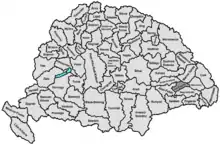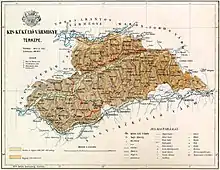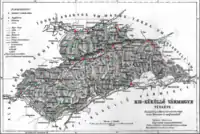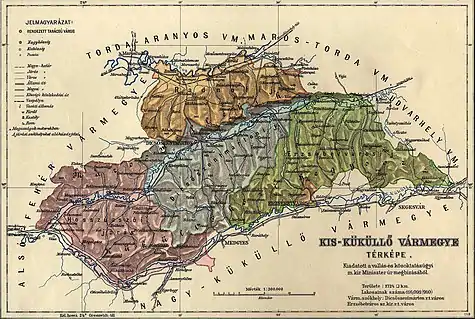| Kis-Küküllő County | |
|---|---|
| County of Kingdom of Hungary | |
| 1876–1920 | |
.svg.png.webp) Coat of arms
| |
 | |
| Capital | Dicsőszentmárton |
| Area | |
| • Coordinates | 46°20′N 24°18′E / 46.333°N 24.300°E |
• 1910 | 1,724 km2 (666 sq mi) |
| Population | |
• 1910 | 116091 |
| History | |
• Established | 1876 |
| 4 June 1920 | |
| Today part of | Romania |
| Târnăveni is the current name of the capital | |
Kis-Küküllő was an administrative county (comitatus) of the Kingdom of Hungary. Its territory is now in central Romania (central Transylvania). Kis-Küküllő is the Hungarian name for the river Târnava Mică. The capital of the county was Dicsőszentmárton (now Târnăveni).
Geography

Kis-Küküllő county shared borders with the Hungarian counties Alsó-Fehér, Torda-Aranyos, Maros-Torda, Udvarhely, and Nagy-Küküllő. The river Mureș formed part of its northern border, the river Târnava Mare its southern border. The Târnava Mică River flowed through the county. Its area was 1,724 km2 (666 sq mi) around 1910.
History
Kis-Küküllő County came into existence in 1876, when the administrative structure of Transylvania was changed and Küküllő County was split. In 1920, by the Treaty of Trianon, the county became part of the Kingdom of Romania. After the Second Vienna Award, a little part of the former county became part of Hungary again and was assigned to the recreated Maros-Torda County. Its territory lies in the present Romanian counties Mureș (around Târnăveni), Alba (the south-west), and Sibiu (the south, around Dumbrăveni).
Demographics

| Census | Total | Romanian | Hungarian | German | Other or unknown |
|---|---|---|---|---|---|
| 1880[1] | 92,214 | 44,372 (49.92%) | 21,604 (24.31%) | 16,976 (19.10%) | 5,933 (6.67%) |
| 1890[2] | 101,045 | 49,573 (49.06%) | 27,652 (27.37%) | 18,273 (18.08%) | 5,547 (5.49%) |
| 1900[3] | 109,197 | 55,276 (50.62%) | 32,491 (29.75%) | 19,292 (17.67%) | 2,138 (1.96%) |
| 1910[4] | 116,091 | 55,585 (47.88%) | 34,902 (30.06%) | 20,272 (17.46%) | 5,332 (4.59%) |
| Census | Total | Greek Catholic | Calvinist | Lutheran | Eastern Orthodox | Roman Catholic | Unitarian | Jewish | Other or unknown |
|---|---|---|---|---|---|---|---|---|---|
| 1880 | 92,214 | 33,520 (36.35%) | 15,701 (17.03%) | 16,794 (18.21%) | 16,627 (18.03%) | 3,999 (4.34%) | 3,968 (4.30%) | 1,246 (1.35%) | 359 (0.39%) |
| 1890 | 101,045 | 35,781 (35.41%) | 17,979 (17.79%) | 18,174 (17.99%) | 18,073 (17.89%) | 4,806 (4.76%) | 4,483 (4.44%) | 1,418 (1.40%) | 331 (0.33%) |
| 1900 | 109,197 | 39,047 (35.76%) | 19,936 (18.26%) | 19,089 (17.48%) | 18,925 (17.33%) | 5,690 (5.21%) | 4,874 (4.46%) | 1,621 (1.48%) | 15 (0.01%) |
| 1910 | 116,091 | 41,323 (35.60%) | 21,995 (18.95%) | 20,159 (17.36%) | 19,438 (16.74%) | 6,488 (5.59%) | 4,916 (4.23%) | 1,766 (1.52%) | 6 (0.01%) |
Subdivisions

In the early 20th century, the subdivisions of Kis-Küküllő County were:
| Districts (járás) | |
|---|---|
| District | Capital |
| Dicsőszentmárton | Dicsőszentmárton (now Târnăveni) |
| Erzsébetváros | Erzsébetváros (now Dumbrăveni) |
| Hosszúaszó | Hosszúaszó (now Valea Lungă) |
| Radnót | Radnót (now Iernut) |
| Urban districts (rendezett tanácsú város) | |
| Dicsőszentmárton (now Târnăveni) | |
| Erzsébetváros (now Dumbrăveni) | |
Notes
References
- ↑ "Az 1881. év elején végrehajtott népszámlálás főbb eredményei megyék és községek szerint rendezve, II. kötet (1882)". library.hungaricana.hu. Retrieved 28 September 2021.
- ↑ "A Magyar Korona országainak helységnévtára (1892)". library.hungaricana.hu. Retrieved 29 September 2021.
- ↑ "A MAGYAR KORONA ORSZÁGAINAK 1900". library.hungaricana.hu. Retrieved 29 September 2021.
- ↑ "KlimoTheca :: Könyvtár". Kt.lib.pte.hu. Retrieved 29 September 2021.
